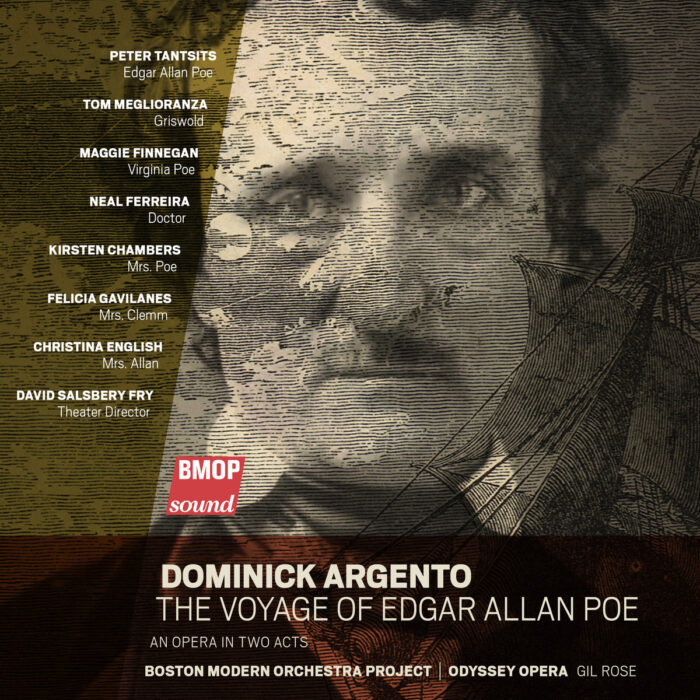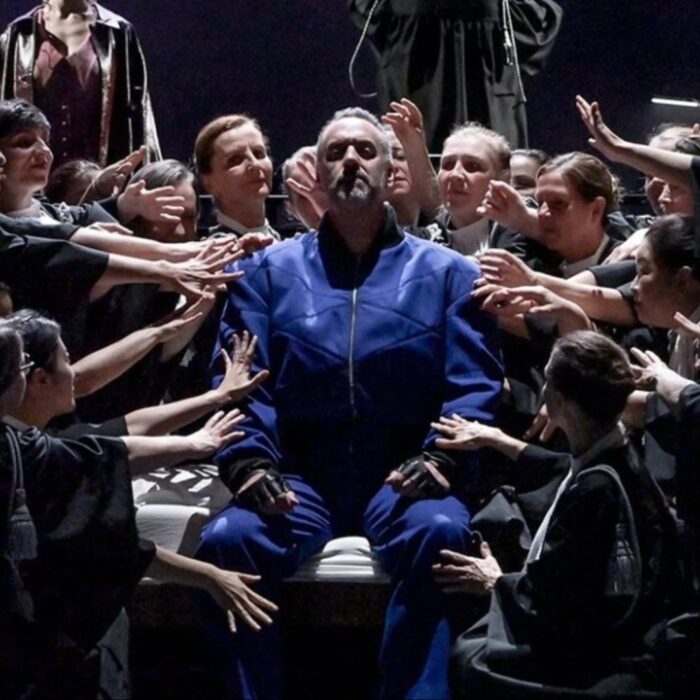
Innsbruck 2022-23 Review: Boris Godunov
Strassberger’s Reading Highlights Themes Embedded In Russian History
By Alan Neilson(Photo: Birgit Gufler)
As many countries around the world lose contact with their national histories, Russia still allows its long tentacles to press forward into the present. Its distinctive institutions, including the political and the religious, as well as its artistic, musical, literary and traditional folk cultures have, deliberately or otherwise, maintained close connections with their historical roots, making them instantly recognizable to people across the globe as Russian. History has also determined, or so it appears, that there should be a recurrence in the life of the nation. Which, despite change ensures Russia in many respects, is the same as in the past. Under the tsars, the people were downtrodden, spied upon, sent to Siberian prison camps and ruled as the emperor saw fit. After the tsars were overthrown and replaced by a new political class, the people’s situation changed little; they were downtrodden, spied upon, sent to Siberian prison camps and ruled as their new leaders wanted them to be. Therefore, it is not a surprise that Putin has been able to assume almost total control over the Russian state and that he is often referred to as a tsar or a commissar.
Such a connection between past and present, of course, also works in the other direction. When power relationships, institutions, systems and values change little, the events of the past can be more easily accessed and understood in the present. The American director, Thaddeus Strassberger, charged with the Tiroler Landestheater’s production of “Boris Godunov,” used our understanding and familiarity with Russian history and its distinctive culture to present the narrative both inside and outside of the actual period in which the events occurred. The consequences of which were to emphasize the unchanging nature of political power relationships in Russia and to bring the human side of Boris into the present, while not misrepresenting the context in which he operated.
An Imaginative & Colorful Staging
Strassberger, who also acted as the set and costume designer, created a staging that was imaginative, colorful and visually stunning. The stage was dominated by a golden-paneled façade topped with golden cupolas and large doors, positioned centrally, through which the characters could enter and exit. There was an alcove in its upper section above the doors, which allowed Boris to look down from above or allowed the shadowy Shuisky to keep an eye on what was happening. The coronation scene in particular, with its large crowds in lavish costumes standing in front of the façade with the crowned Boris in the centre holding an orb and scepter draped in ermine, was aesthetically stunning.
It was also a versatile set. The rotating stage allowed for seamless set changes; the façade, turning 180 degrees, became a white wall onto which were projected images, in front of which were distributed well-chosen props to enhance the context. Among others, there were projections of the Kremlin, of television screens, and of the canopy of a circus tent. Pimen’s dark cell was expertly depicted through the projections of images of angels and demons, in front of which stood Pimen, dwarfed by oversized books and candles, which neatly encapsulated his relationship to the scriptures and the Holy Russian Church.
Strassberger’s conception, however, was not solely an aesthetic one. In fact, he was careful to ensure that each of the opera’s seven scenes were crafted to furnish the audience with the necessary information to support the narrative and to provide symbols and images that allowed it to contextualize the work both within its specific historical setting, of Russia at the beginning of the 17th century, and within its wider historical framework, which meshed together periods of Russian history up to the present day. The opening of the opera, for example, marked the significant event of a change in Russia’s ruler, with a television newsreader announcing the death of Tsar Feodor I, Boris’ predecessor, followed by a short clip of a ballet dancer.
Obviously, costumes were also used to create allusions and connections between eras. The Russian people were often costumed in traditional dress, although sometimes with anomalous items from different periods. Even the Tsarevich, Feodor, whom we first see playing with a tank at his desk, was dressed in a casual 19thcentury Russian smock but with a pair of modern casual shoes. In the scene at the inn, which took on the appearance of a derelict building for the homeless, the people wore a ragbag of clothes, including modern-day casual wear. The soldiers who searched the inn were costumed in modern-day fatigues, but the police who controlled the crowds in scene one were dressed in non-specific black clothes that suggested only that they were Russian.
It may sound like a rude mixture of styles lacking coordination, but it worked perfectly. The characters emerged from out of the expansive tapestry that is Russian history and stepped into the present day. Their deep connection to Russia and to the what appears to be eternal truths that define the power relationships between its leaders and its people were clearly revealed, and allowed the subjects become a symbolic expression of a greater theme.
Strassberger was, however, equally successful in fully developing each scene so that significant points were highlighted, allowing the narrative to be easily followed. In scene three, in Pimen’s cell an unconscious Dmitry, the rightful heir to the Russian throne, is brought in by a nun and a group of shady looking men. Although, it is normally accepted by directors that he was murdered before the opera begins. Strassberger does indeed have him die almost immediately. But, the incident is used to precipitate the conversation between Pimen and Grigori about Dmitry that gives the novice the idea of becoming a pretender. It is a simple device, but one that adds to the scene.
Strong Individual Performances From The Cast
The production was strongly cast throughout, including singers in minor roles producing well-defined performances.
In the title role was Bulgarian bass Ivo Stanchev. Although there have been rougher, wilder, more animated vocal characterizations that have brilliantly brought out Boris’ vicious and dominating personality, Stanchev’s more refined approach was no less convincing. He possesses a warm, attractive, versatile voice, which he used to create a multi-layered character. In the early scenes, he presented Boris as calm, cool and controlled, but with a dark undercurrent, which, in the latter scenes, he imbued with an increasingly violent emotional intensity. The contrasts made his dissent into madness very real, very believable and his suffering and isolation became painfully honest. Nothing was overstated. Likewise, his acting was finely crafted to develop his character. His confidence and strong physical presence allowed him to dominate, and when his anger did explode, it could be sudden and extreme, as when he stabbed Shuisky through the hand when he brought bad news about the pretender.
Although showing little in the way of emotion, tenor Łukasz Załęski characterized Prince Shuisky as a thoroughly loathsome individual. He acted more like a bureaucrat than a prince, exercising his power in the shadows, watching what was going on, working against the Tsar’s interests, but never openly confronting him. From scene five, his insipid presence and controlled singing acted as the perfect foil to Boris’ emotionally tormented disintegration.
Bass Johannes Maria Wimmer gave an impressive performance as the monk Pimen, in which he captured his character’s religious fervor and political interests. The scene is dominated by his lengthy monologues, which allowed him to display his colorful, versatile voice and sensitive and expressively crafted phrasing.
Grigori Otrepjew, who masquerades as Dmitry, was given an energetic and punchy performance by tenor Florian Stern. His voice displayed versatility and quality over the range, which he used intelligently to create a compelling singing performance with emotionally crafted phrases replete with neatly placed accents. His acting was also nicely fashioned, with his presentation of Dmitry as a homeless fugitive particularly convincing.
Baritone Joachim Seipp produced a vibrant, well-defined portrait of Warlaam. He possessed a resonant voice with a beautiful dark sheen and sang with a great sense of freedom in what was a lyrically engaging presentation. He thoroughly deserved the enthusiastic applause of the audience at the final curtain.
Dale Albright created quite a splash with his show-stopping performance as the Holy Fool. He appeared as an updated modern version in the guise of a circus clown. Initially, he appeared on television; he was a celebrity, trusted by the people. As the narrative unfolds, however, the clown became more circumspect as he sat alongside the broken Boris in what was a very moving stage picture.
Soprano Susanna von der Burg displayed versatility with her convincing portrayal of two very different characters: Xenia’s nurse, for which she was caring and quiet; and the Innkeeper, for which she was busy, feisty and streetwise.
The Tsarevich Feodor was played by mezzo-soprano Irina Maltseva, who produced a convincing presentation of the young boy. She had a very appealing, colorful voice, which she used sensitively to flesh out his character. Her acting was impressive enough to mask the fact that she was performing a trouser role, which is no easy task.
Soprano Annina Wachter was a hysterical Xenia. Her bright, piercing voice wonderfully conveyed her brittle emotional state.
Bass Stanislav Stambolov, cast as both Mikitisch the police chief, and as a border guard, made great impressions in both roles. He possessed a resonant, distinctive voice which he convincingly enveloped with the necessary aggression as he threatened the people in the crowded square.
The Secretary of the Duma, Schtschelkalow, costumed in a military uniform, was played by baritone Alec Avedissian, who produced a well-sung and well-presented performance.
Tenor Sascha Zarrabi showed off his pleasing tenor with convincing performances in the roles of the monk, Missail, and a boyar.
The enlarged chorus, along with the children’s chorus, were in excellent form under the direction of Michel Roberge. The voices possessed an emotional vibrancy and energy that magnificently captured the people’s hopes and suffering. They also exhibited a pleasing versatility that allowed the voices to move between passages of lyrical beauty and scenes in which they punched out the lines with vigor as their voices soared effortlessly above the orchestra.
The Tiroler Symphonieorchester Innsbruck, under the direction of the conductor, Oliver von Donhányi, produced a clear-sounding reading that revealed the rich textures and fascinating musical detail of the score. It was also a dramatically sensitive presentation that developed pleasing rhythmic and dynamic contrasts. If there was a negative criticism, it was that, on occasion, it lacked the expected atmospheric heaviness. Von Donhányi’s coordination of the full musical forces was expertly handled throughout and successfully achieved a pleasing balance.
Overall, this was a first-class production in which Strassberger’s colorful and dramatically forceful reading combined perfectly with von Donhányi’s excellent musical direction and was topped by some excellent performances from the cast.
The version presented was Mussorgsky’s original 1869 version. The text was by Alexander Pushkin and Nikolay Karamsin.



